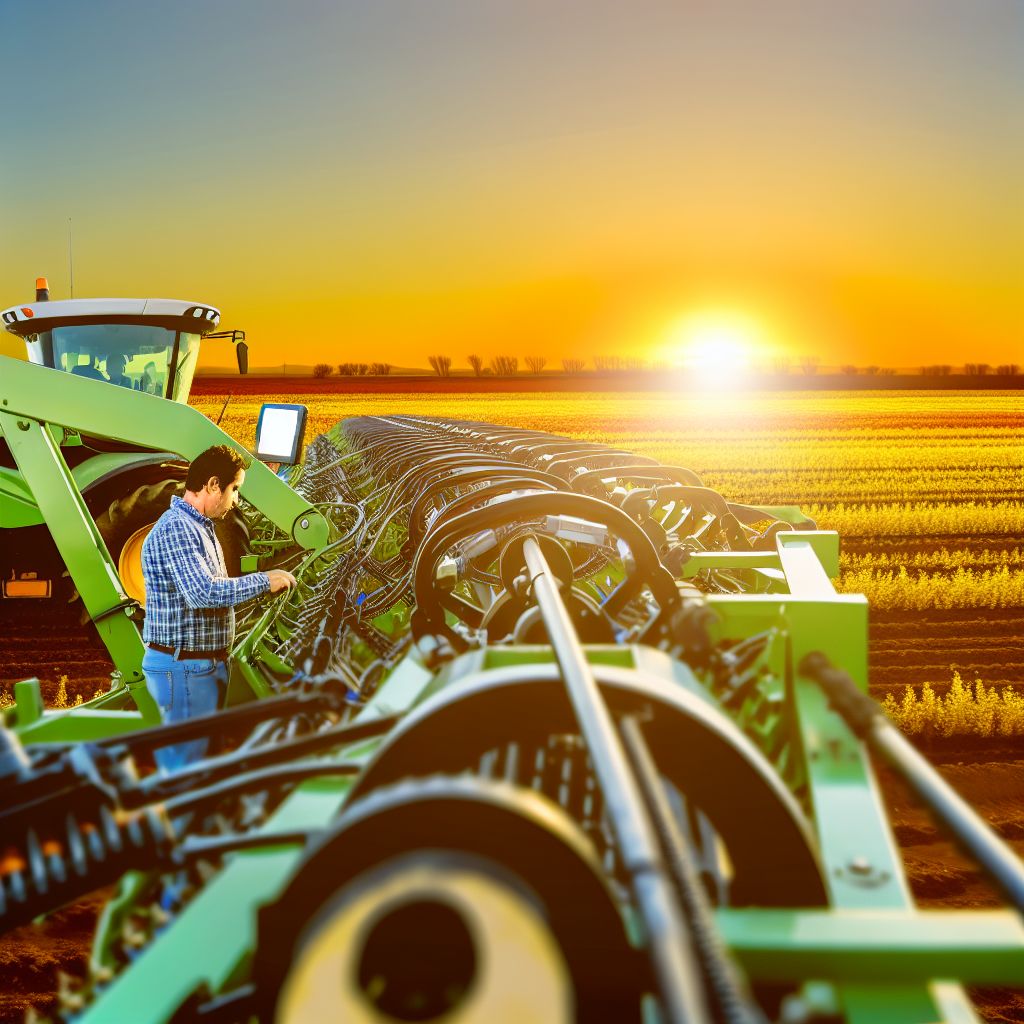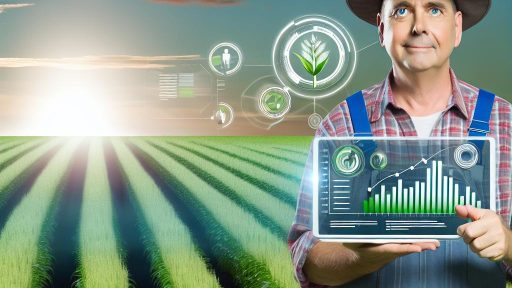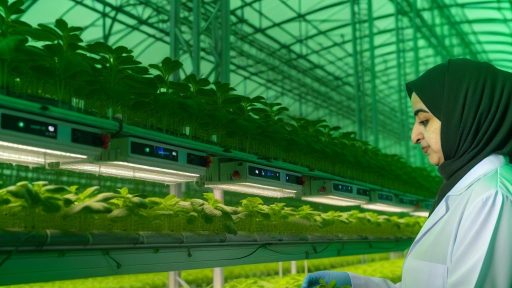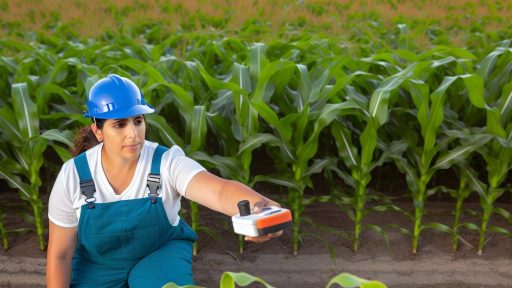Introduction to Automated Machinery in Farming
Automated machinery revolutionizes modern farming.
This technology enhances efficiency and productivity.
Farmers can now manage their resources more effectively.
Automation reduces labor costs and improves crop yields.
Benefits of Automation
First, automated machinery saves time.
Farmers can allocate their time to other important tasks.
Moreover, it ensures consistent performance across large fields.
In addition, automation minimizes human error.
This aspect significantly boosts reliability in operations.
Types of Automated Machinery
A variety of automated machinery exists today.
For instance, tractors equipped with GPS offer precision tilling.
Drones assist with crop monitoring and spraying.
Robotic harvesters improve harvesting efficiency dramatically.
Moreover, automated irrigation systems ensure optimal water usage.
Cost Considerations
Investing in automated machinery can seem daunting.
Transform Your Agribusiness
Unlock your farm's potential with expert advice tailored to your needs. Get actionable steps that drive real results.
Get StartedHowever, various cost-effective options are available.
Many manufacturers offer financing plans specifically for farmers.
Additionally, governments may provide subsidies for such technology.
Farmers should consider total cost of ownership before purchasing.
Trends in Agricultural Automation
Automation in farming continues to evolve rapidly.
New innovations are frequently emerging in the market.
Smart technology integration enhances data-driven decisions.
As a result, farmers can optimize their operations even further.
This trend is expected to grow in the coming years.
Benefits of Cost-Effective Automation for Farmers
Enhancing Efficiency
Cost-effective automation streamlines farming operations significantly.
It reduces manual labor and minimizes human error.
Farmers can achieve more tasks in less time.
This efficiency allows for better resource management.
Reducing Operational Costs
Automation can dramatically lower operational costs.
By minimizing labor expenses, farmers increase their profit margins.
Furthermore, automated machinery often uses energy more efficiently.
This leads to reduced fuel expenses over time.
Improving Crop Yields
Automated systems enhance precision in farming practices.
Such precision leads to improved crop management.
Farmers can implement exact planting, watering, and harvesting.
This method increases overall crop yields significantly.
Facilitating Data-Driven Decisions
Automation allows farmers to collect data effortlessly.
With this data, they can make informed decisions.
Data-driven insights help optimize farming strategies.
Showcase Your Farming Business
Publish your professional farming services profile on our blog for a one-time fee of $200 and reach a dedicated audience of farmers and agribusiness owners.
Publish Your ProfileAdditionally, farmers can identify potential issues early.
Adapting to Market Changes
Cost-effective automation enables farmers to adapt quickly.
They can respond to changing market demands efficiently.
This adaptability is critical in today’s fast-paced agricultural landscape.
Farmers can shift their production based on current trends.
Enhancing Sustainability
Automation contributes significantly to sustainable farming practices.
It optimizes resource usage and minimizes waste.
Farmers can monitor water usage and reduce chemical inputs.
Such practices support environmental health and sustainability.
Types of Automated Machinery Available for Various Farm Sizes
Small-Scale Farms
Small farms often need versatile and compact machinery.
These options are designed to maximize efficiency in limited spaces.
Farmers like Emma Clark utilize small tractors for diverse tasks.
Handheld devices also prove useful for precision tasks.
Automated seeders cater to the unique needs of small-scale agriculture.
Medium-Scale Farms
Medium-sized farms can benefit from more specialized machinery.
Farmers such as Mark Thompson adopt automated planters and harvesters.
These machines save time while improving crop yields.
More robust tractors help manage larger plots of land.
The investment often leads to substantial returns over time.
Larger Farms
Large farms require the most advanced automated solutions.
Precision farming technologies significantly enhance productivity.
For instance, drones can monitor crop health efficiently.
Moreover, self-driving tractors simplify the planting and harvesting process.
Farmers like Sarah Lee rely on harvesters equipped with AI for efficiency.
Shared Machinery Options
Some farmers opt for cooperative machinery models.
This approach enables sharing expensive equipment among local farms.
Cooperatives allow smaller farms access to advanced technology.
Additionally, farmers save money on maintenance and repairs.
Such collaborations can strengthen community ties within agriculture.
Gain More Insights: Optimizing Resource Use in Controlled Environment Agriculture
Considerations for Choosing Cost-Effective Machinery
Understanding Your Needs
Identifying your specific farming needs is crucial.
Assess the types of crops you grow and their unique requirements.
Evaluate the size of your farm and the scale of operations.
Consider the types of tasks you need assistance with, such as planting or harvesting.
Budget Constraints
Establish a clear budget before purchasing machinery.
Review both initial costs and long-term maintenance expenses.
Look for financing options that suit your financial situation.
Consider leasing machinery as a cost-saving alternative.
Researching Options
Conduct thorough research on available machinery options.
Read reviews from other farmers who have used these machines.
Showcase Your Farming Business
Publish your professional farming services profile on our blog for a one-time fee of $200 and reach a dedicated audience of farmers and agribusiness owners.
Publish Your ProfileAttend agricultural shows to see machines in action.
Network with peers to gather insights on their experiences.
Efficiency and Productivity
Focus on machines that enhance efficiency and productivity.
Choose equipment that reduces labor costs and minimizes time spent on tasks.
Invest in technology that automates repetitive processes.
Analyze how machinery will improve your overall yield.
Support and Maintenance
Check the availability of customer support and service options.
Look for machinery from reputable manufacturers known for their service.
Evaluate the availability of spare parts in case of repairs.
Consider warranty options that provide additional peace of mind.
Environmental Impact
Consider the environmental impact of the machinery you choose.
Select equipment that promotes sustainable farming practices.
Look for energy-efficient models that reduce fuel consumption.
Evaluate the carbon footprint associated with the machinery’s operation.
Uncover the Details: Drone Technology Transforming Farm Operations
Case Studies: Successful Implementation of Automated Machinery
Introduction to Automation in Agriculture
Automated machinery brings efficiency to modern farming practices.
Farmers can reduce labor costs significantly through automation.
This section explores successful case studies.
Case Study One: Sun Valley Farms
Sun Valley Farms implemented robotic harvesters in their orchards.
The decision aimed to increase productivity during peak seasons.
After installation, the farm saw a 30% increase in fruit harvesting efficiency.
Moreover, the consistent quality of harvested fruit improved.
Automated machinery allowed workers to focus on more skilled tasks.
Case Study Two: Green Horizon Organic Farms
Green Horizon introduced autonomous tractors for field plowing.
This change led to reduced operational costs and fuel consumption.
Farmers reported a 25% decrease in time spent on plowing tasks.
Additionally, soil compaction decreased, improving crop health.
Ultimately, this case demonstrates cost savings and sustainability.
Case Study Three: Urban Roots Hydroponics
Urban Roots adopted vertical farming techniques with automated systems.
These systems monitor nutrient levels and water usage effectively.
As a result, crop yields increased by 40% within six months.
Furthermore, automation enhanced energy efficiency in the facility.
This case illustrates how technology can revolutionize urban agriculture.
Case Study Four: Crescent Lake Dairy
Crescent Lake Dairy integrated automated milking systems into their operations.
This innovation reduced labor costs and improved cow welfare.
The farm experienced a 20% increase in milk production.
Moreover, cows exhibited reduced stress levels due to better handling.
This case highlights automation’s positive impact on livestock management.
Lessons Learned from Successful Implementations
Successful automation requires clear goals and planning.
Each case study emphasizes the importance of training for staff.
Showcase Your Farming Business
Publish your professional farming services profile on our blog for a one-time fee of $200 and reach a dedicated audience of farmers and agribusiness owners.
Publish Your ProfileFeedback from employees enhances the implementation process.
Investments in technology lead to substantial long-term benefits.
Farmers must remain adaptable to changing technologies.
You Might Also Like: Secure Financial Management For Farmers Through Agri-Fintech Solutions

Comparative Analysis of Costs: Manual vs. Automated Farming
Understanding Manual Farming Costs
Manual farming often incurs lower upfront costs.
However, it requires significant ongoing labor expenses.
Crops demand constant attention and care from farmers.
Labor costs can accumulate quickly during peak seasons.
Moreover, manual methods can lead to inconsistencies in crop quality.
Exploring Automated Farming Costs
Automated farming technologies entail higher initial investments.
Despite this, they can reduce labor costs over time.
Automation optimizes resource use and enhances efficiency.
Furthermore, it minimizes human error, enhancing productivity.
Farmers can achieve consistent crop quality with automation.
Cost Comparison Breakdown
Let’s delve into key cost categories for comparison.
- Initial investment costs
- Maintenance and repair expenses
- Labor costs over time
- Yield quality and quantity outcomes
- Long-term sustainability benefits
Long-Term Financial Implications
Farmers should consider past investment costs versus returns.
While automation can appear more costly initially, it often pays off.
Ultimately, the choice hinges on specific farm needs and goals.
Calculating the return on investment is crucial for decision-making.
Case Studies of Cost-Efficient Automation
Numerous farmers have successfully integrated automation.
For instance, Clara’s orchard uses automated watering systems.
This innovation cut her water costs by 30%.
Likewise, Alex has benefited from automated harvesting machines.
He reduced labor costs significantly and increased yield efficiency.
See Related Content: Internet of Things (IoT) Applications in Sustainable Agriculture
Future Trends in Agricultural Automation Technology
Increasing Use of Robotics
Robotics is becoming a game-changer in agriculture.
Farmers increasingly rely on robotic systems for planting and harvesting.
These machines can operate around the clock, enhancing productivity.
Furthermore, they reduce the need for manual labor significantly.
Advancements in AI and Machine Learning
Artificial Intelligence is revolutionizing farm management.
Farmers can now utilize AI for precision agriculture.
This technology analyzes vast amounts of data efficiently.
Consequently, farmers can make informed decisions promptly.
Implementation of IoT Devices
The Internet of Things (IoT) is transforming agricultural practices.
Irrigation systems now operate with real-time data.
Sensors collect vital information about soil and crop conditions.
This connectivity allows for better resource management.
Focus on Sustainability
Sustainable practices are becoming essential in agriculture.
Automation helps reduce waste and conserve resources.
Moreover, eco-friendly technologies have gained popularity among farmers.
Showcase Your Farming Business
Publish your professional farming services profile on our blog for a one-time fee of $200 and reach a dedicated audience of farmers and agribusiness owners.
Publish Your ProfileThis shift leads to a more sustainable future for agriculture.
Affordability of Automated Solutions
Cost-effective automation solutions are emerging.
Farmers can now access advanced technologies within their budgets.
Subsidies and grants support investment in automation.
As a result, more farmers can adopt these technologies.
Integration of Data Analytics
Data analytics is crucial for modern farming success.
Farmers leverage analytics to optimize crop yields and reduce costs.
This technology provides insights based on historical performance.
Thus, it enables smarter and more efficient farming practices.
Resources for Financing Automated Machinery Options
Government Grants and Subsidies
Farmers can access various government grants aimed at supporting automation.
These grants often help cover the costs of machinery upgrades.
State and federal programs vary, providing diverse options.
For instance, the USDA provides specific funding opportunities.
Farmers should research available local programs and eligibility requirements.
Low-Interest Loans and Financing Options
Many financial institutions offer low-interest loans for agricultural machinery.
Farmers should compare rates and terms from different lenders.
Credit unions may provide favorable financing options for members.
Additionally, equipment dealers often partner with lenders to offer loans.
As a result, farmers can find financing that suits their budget needs.
Cooperative Purchasing Programs
Joining cooperative purchasing programs can reduce costs significantly.
These programs allow farmers to buy equipment in bulk at discounted rates.
Farmers can leverage their combined purchasing power for better deals.
Local farming cooperatives often facilitate these group purchases.
Furthermore, farmers can share the machinery, optimizing usage.
Crowdfunding Platforms
Farmers can explore crowdfunding as a modern financing option.
Platforms like Kickstarter or GoFundMe allow people to invest in agricultural projects.
Presenting a compelling proposal can attract potential supporters.
Moreover, farmers can market their automation goals to the public.
This approach may lead to securing funds from community members.
Tax Incentives and Deductions
Farmers can benefit from various tax incentives related to machinery purchases.
For instance, Section 179 of the IRS tax code allows for immediate deductions.
Understanding applicable tax breaks can save farmers considerable money.
It’s wise to consult with a tax professional for personalized advice.
Proper planning can maximize financial benefits for farmers.
Additional Resources
Automation and digitization of agriculture using artificial intelligence …
Enhancing smart farming through the applications of Agriculture 4.0 …




